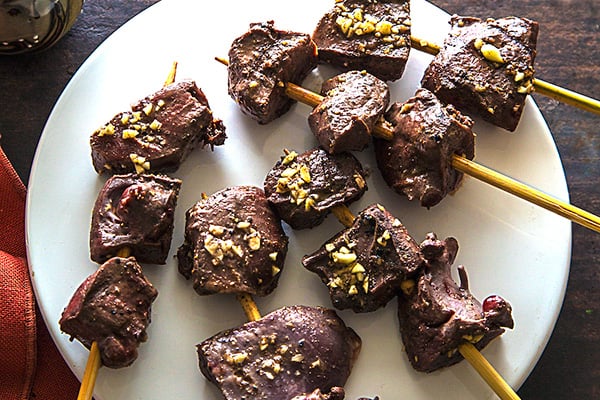
Today’s recipe for marinated beef heart kebabs comes from the cookbook by Amanda Torres with Milagros Torres, Latin American Paleo Cooking. This book is a great addition to my repertoire as I don’t do very many recipes from that part of the world. I’ve bookmarked the tamales and empanadas already, but I wanted to share something a little more unusual from the book, so beef heart it is!
Beef heart is an excellent choice if you are new to eating offal, because it tastes like a fine steak.
If you’re lucky, your butcher will be able to sell you a cleaned and cut heart rather than an entire heart.
This traditional Peruvian dish marinates the heart in a delicious sauce that you can actually use to marinate any cut of meat.
If you are too squeamish to cook heart, you can use any steak or even cubed chicken breast instead. But I, and the authors, highly recommend that you give beef heart a chance!
Notes For Cooking Beef Heart Kebabs
Ají panca paste can be ordered online if you can’t find it locally, or you can substitute 1 to 2 tablespoons (7.5 to 15 g) of pasillo or ancho chile powder. Taste the marinade before adding the meat and adjust to your preferred level of spiciness.
AIP compliant: Omit the ají panca paste, black pepper and the cumin for a tangy garlic-lime marinade.
Want to Save This Recipe?
Enter your email & I'll send it to your inbox. Plus, get great new recipes from me every week!
By submitting this form, you consent to receive emails from Cooked & Loved

Ingredients
- ½ cup freshly squeezed lime juice
- 3 to 4 tablespoons ají panca paste 48-64 g (see note for substitutes)
- 6 cloves garlic peeled and minced
- 1½ teaspoons fine Himalayan salt
- 1 teaspoon freshly ground black pepper
- 1 teaspoon ground cumin powder
- 4 tablespoons extra-virgin olive oil 60 ml, divided
- 1 lb. beef heart 455 g, trimmed
Instructions
- Combine the lime juice, ají panca paste, garlic, salt, black pepper, cumin and 2 tablespoons (30 ml) of the olive oil in a glass container with a lid.
- If not already cleaned, trim the heart of fat, connective tissue and blood vessels. Cut the meat into equal-size chunks, 1 to 2 inches (2.5 to 5-cm) across and 0.5 inch (1.3-cm) thick.
- Place the heart chunks in the marinade and toss to combine. Cover and refrigerate for a minimum of hour, up to overnight.
- Before grilling, have 6 to 8 skewers ready. If using wooden or bamboo skewers, soak them in water for at least 30 minutes.
- Meanwhile, prepare the grill for direct cooking over medium heat (325-375 F / 170 C). Depending on type of grill, this may take 15 to 20 minutes.
- Thread the heart pieces onto the skewers. Make sure each piece is spread as flat as possible and leave a very small space between each piece.
- Once the grill is hot, brush the cooking grates clean, if necessary (to prevent sticking). Grill the skewers over direct medium heat for 2 to 3 minutes per side for medium rare or to 5 minutes for medium well done. Brush the kebabs with the remaining olive oil at least once during cooking. Do not overcook or else the beef heart will become tough and rubbery.
- Serve immediately as an appetizer or with your favourite sides for a meal. This pairs very well with plantain tostones.
Nutrition
About The Cookbook
You can find more delicious Latin American paleo recipes in Latin American Paleo Cooking cookbook.
Featuring over 80 authentic recipes from across Latin America (Puerto Rico, Cuba, Colombia, Peru and Venezuela, among others) it brings the flavours of Latin home cooking right into readers’ Paleo-friendly kitchens.
There are recipes for Arepas, Empanadas al Horno (Baked Meat Turnovers) Ropa Vieja (Shredded Beef in Tomato Sauce), Pollo a la Brasa (Marinated Roasted Chicken), Yuca Fries, and even desserts like Flan de Coco, Tres Leches Cake and Hojaldre (Puerto Rican Spice Cake) that are all as flavourful as they are healthy.

Save This Beef Heart Kebabs To Pinterest








Hey Irena, I know you’re not the author of the recipe but just wanted to throw in my 2 cents… there are heaps of Peruvian dishes that can be made a million different ways but, in my opinion, anticuchos is not one of them. You can use whatever meat you want but the acidic element in the marinade should be vinegar (preferably red wine vinegar) and dried oregano (the cumin is optional).
Gaby, thanks so much for sharing! You’re right that I should have listed the red wine vinegar as a more traditional option for the marinade. It’s worth noting that I wrote the book for people who have to follow specific diets for their health, and vinegars are an ingredient that many people in my corner of the internet can struggle to tolerate due to the fermentation. I also personally prefer the flavor of lime vs vinegar and have been making them this way for many years. I truly did take great care to strive for authenticity in these recipes while adhering to the specific dietary restrictions on Paleo and AIP diets, so I am kicking myself for missing this. If only it were as easy to edit a book as it is a blog post 😉